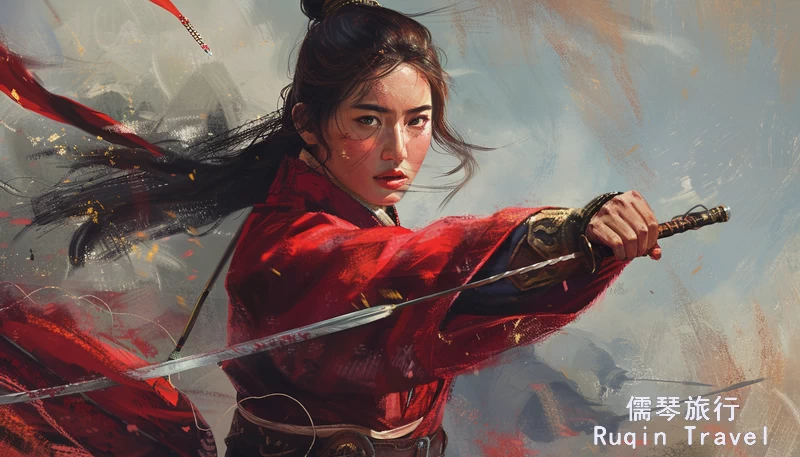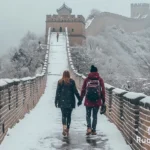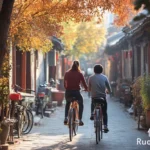Chinese folktales and legends are an inwoven part of Chinese culture. These stories have been passed down through generations. They offer a glimpse into the values, beliefs, and history of China.
For foreign tourists, understanding these tales can enrich their travel experience. This guide aims to introduce you to some of the most famous Chinese folktales and legends.
The Legend of the White Snake
The Legend of the White Snake is one of 、famous Chinese Folktales and Legends. It tells the story of a white snake spirit, Bai Suzhen, who transforms into a woman. She falls in love with a man named Xu Xian. However, their love faces many obstacles.
Firstly, a monk named Fahai believes their union is unnatural. He tries to separate them using his powers. Despite these challenges, Bai Suzhen and Xu Xian’s love remains strong. This story highlights themes of love, sacrifice, and perseverance.
The Monkey King and Journey to the West
The Monkey King, or Sun Wukong, is a central character in the Chinese classic “Journey to the West.” This tale follows a Buddhist monk, Tang Sanzang, on a journey to India. Sun Wukong, with his incredible strength and magical abilities, accompanies him.
Throughout their journey, they encounter various demons and challenges. However, Sun Wukong‘s cleverness and bravery help them overcome these obstacles. This story showcases themes of loyalty, adventure, and spiritual growth.
Mulan: The Heroine of China
Mulan is a legendary figure in Chinese folklore. She is celebrated for her bravery and filial piety. According to the legend, Mulan disguises herself as a man to take her father’s place in the army. She fights bravely and earns great respect.
Eventually, her true identity is revealed, but her bravery is recognized. Mulan’s story is a powerful example of courage and devotion to family.
The Cowherd and the Weaver Girl
The tale of the Cowherd and the Weaver Girl is a romantic legend. It tells the story of a love between Niulang, a humble cowherd, and Zhinü, a fairy weaver. They fall in love and marry, but their union is forbidden by the Queen of Heaven.
Consequently, they are separated by the Milky Way. However, once a year, magpies form a bridge to reunite them. This story is celebrated during the Qixi Festival, China’s version of Valentine’s Day. It emphasizes the themes of love, longing, and reunion.
The Eight Immortals
The Eight Immortals are legendary figures in Chinese mythology. Each immortal has unique powers and a distinct story. They include Zhongli Quan, Zhang Guolao, Lü Dongbin, Li Tieguai, He Xiangu, Han Xiangzi, Cao Guojiu, and Lan Caihe.
These immortals are often depicted in art and literature. They symbolize prosperity and longevity. Their tales offer insights into Daoist beliefs and the pursuit of immortality.
The Butterfly Lovers
The Butterfly Lovers, or Liang Shanbo and Zhu Yingtai, is a tragic love story. Zhu Yingtai, a young woman, disguises herself as a man to attend school. There, she meets Liang Shanbo, and they become close friends. Liang eventually discovers Zhu’s true identity and falls in love with her.
However, Zhu is betrothed to another man. Heartbroken, Liang dies, and Zhu sacrifices herself at his grave. Their spirits transform into butterflies, symbolizing eternal love. This story is often compared to Romeo and Juliet.
The Legend of Chang’e
Chang’e is the Chinese moon goddess. According to the legend, she was the wife of the archer Hou Yi. Hou Yi shot down nine suns to save the Earth, and he was rewarded with an elixir of immortality.
Chang’e drank the elixir and floated to the moon, where she lives to this day. The Mid-Autumn Festival celebrates this legend, and people make mooncakes in her honor. Chang’e‘s story represents themes of love, sacrifice, and immortality.
The Legend of the Jade Rabbit
The Jade Rabbit is another popular figure in Chinese mythology. According to the legend, three immortals disguised themselves as old men and begged for food. A rabbit offered itself as a sacrifice, jumping into the fire.
Touched by its selflessness, the immortals sent the rabbit to the moon, where it became the Jade Rabbit, companion to Chang’e. This tale highlights themes of selflessness, kindness, and sacrifice.
The Legend of Nezha (哪吒)
Nezha is a beloved hero in Chinese mythology. Born to a military commander, Nezha had extraordinary abilities. He fought against demons and protected the people. However, his powers also caused trouble, leading to conflicts with the Dragon King.
Eventually, Nezha sacrificed himself to save his family but was later resurrected. His story emphasizes bravery, sacrifice, and the battle between good and evil.
The Legend of the Red Thread (月老的红线)
The Red Thread of Fate is a popular Chinese legend. It suggests that invisible red threads connect those destined to meet. According to the legend, the old man under the moon, Yue Lao, ties these threads.
No matter how far apart, those connected by the red thread will eventually meet. This story is often cited to explain the idea of destined relationships and emphasizes themes of fate, love, and destiny.
Hua Mulan is another iconic figure in Chinese folklore. She disguised herself as a man to take her ailing father’s place in the army. Mulan fought bravely and earned great respect. Her true identity was eventually revealed, but her bravery and devotion to her family were celebrated. Mulan’s story is a powerful example of courage and filial piety.
The Legend of the Dragon Boat Festival
The Dragon Boat Festival commemorates the poet Qu Yuan. Qu Yuan was a loyal minister who drowned himself in the Miluo River. The people raced in boats to save him, but they were too late.
To keep fish and evil spirits away, they threw rice dumplings into the river. This tradition evolved into the Dragon Boat Festival, celebrated with boat races and eating zongzi (rice dumplings). The story highlights loyalty, sacrifice, and cultural traditions.
The Legend of the Peach Blossom Spring
The Peach Blossom Spring is a utopian tale. A fisherman discovers a hidden valley filled with blossoming peach trees and a peaceful community. The people lived in harmony, unaware of the outside world’s turmoil.
When the fisherman leaves to bring others, he cannot find the valley again. This story symbolizes an ideal world of peace and simplicity, free from the outside world’s troubles.
The Legend of the Yellow Emperor
The Yellow Emperor, or Huangdi, is a legendary figure in Chinese history. He is considered the ancestor of all Chinese people. According to legend, Huangdi ruled wisely and brought prosperity.
He is credited with many inventions, such as the compass, the calendar, and medicine. The Yellow Emperor represents wisdom, innovation, and cultural heritage.
In conclusion, Chinese folktales and legends offer a fascinating glimpse into the country’s rich cultural heritage. They reflect the values, beliefs, and history of China. For foreign tourists, understanding these tales can enhance their travel experience.
From the love story of the Cowherd and the Weaver Girl to the adventures of the Monkey King, these stories are both entertaining and enlightening. As you explore China, take the time to delve into its folklore. You will gain a deeper appreciation of the country’s unique cultural tapestry. Check out China Cultural insights for more information.
More China Cultural Insights
China is a country full of rich traditions, colorful festivals, and fascinating customs that have been passed down through generations. At China Cultural Insights by Ruqin China Travel, we want to help you experience the real China by understanding its culture.



